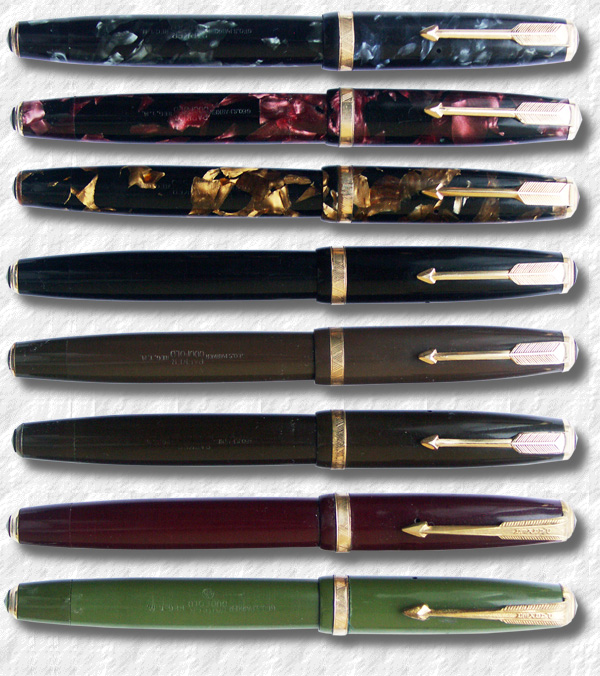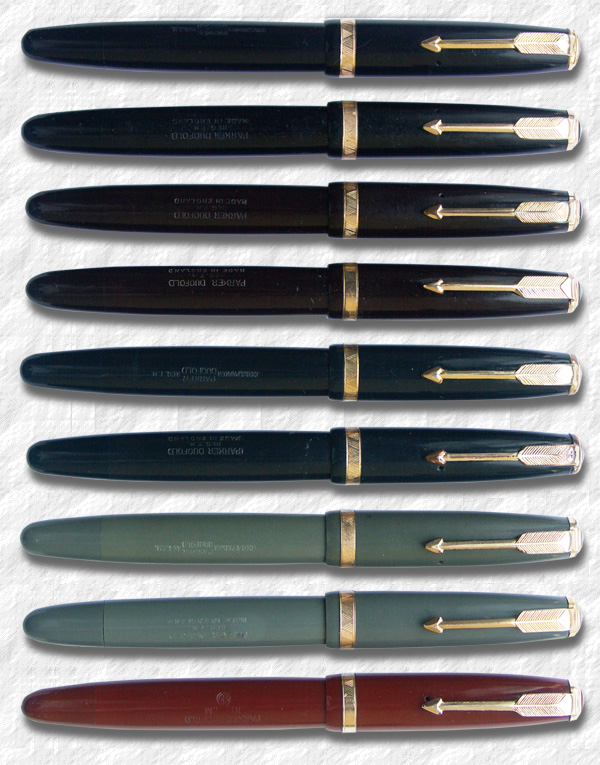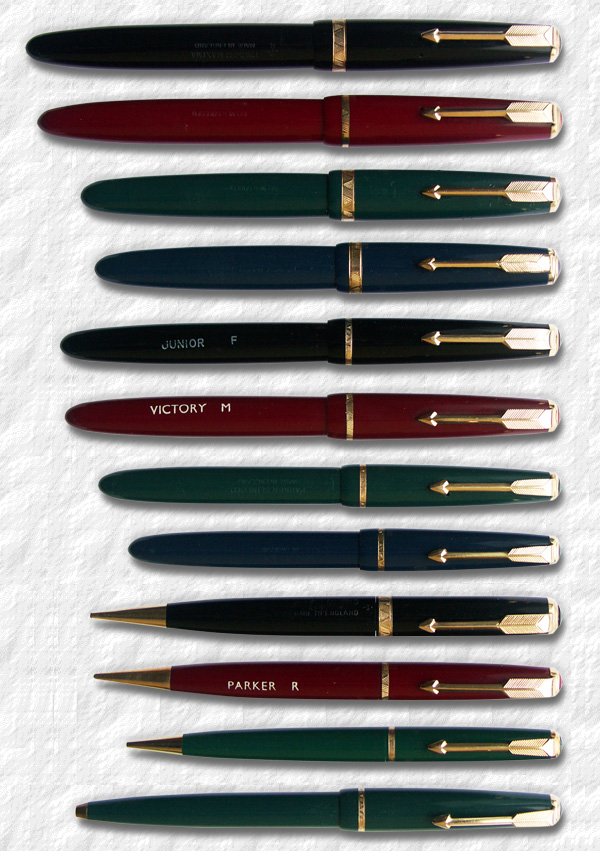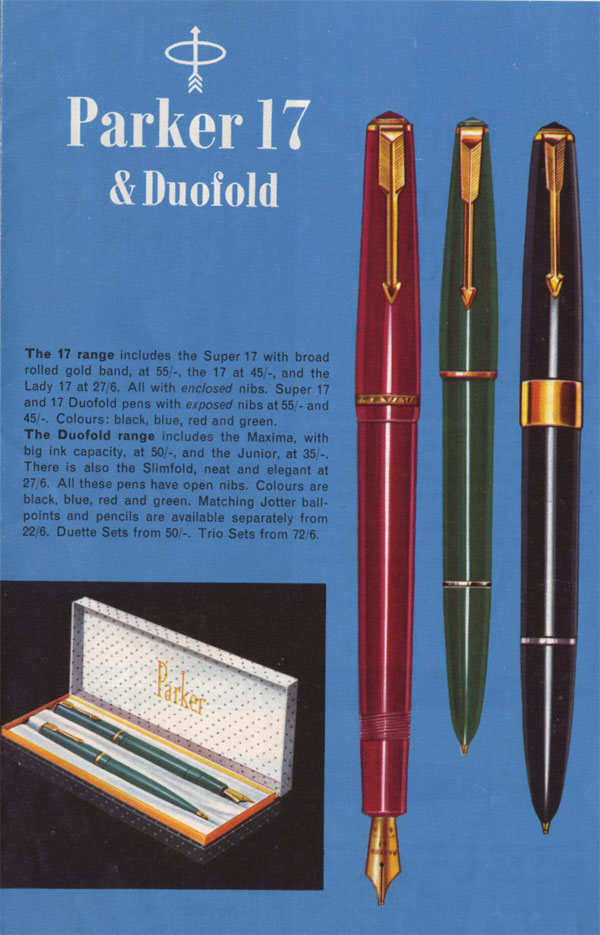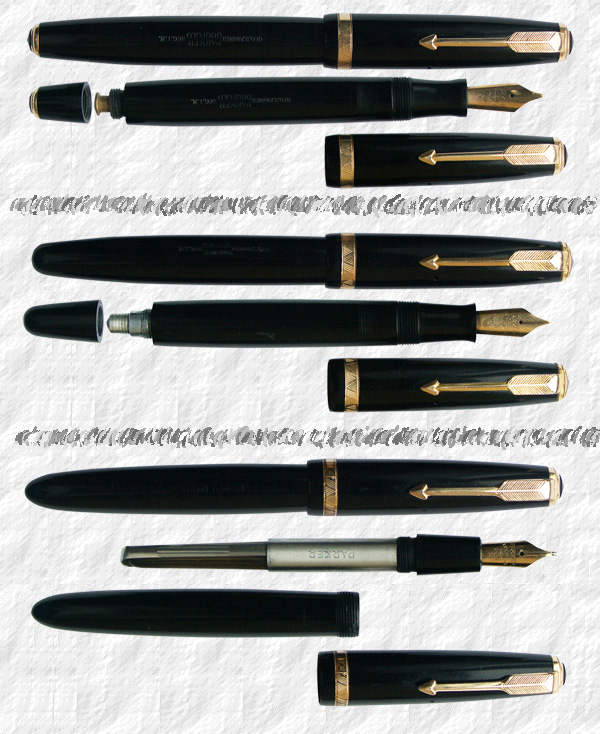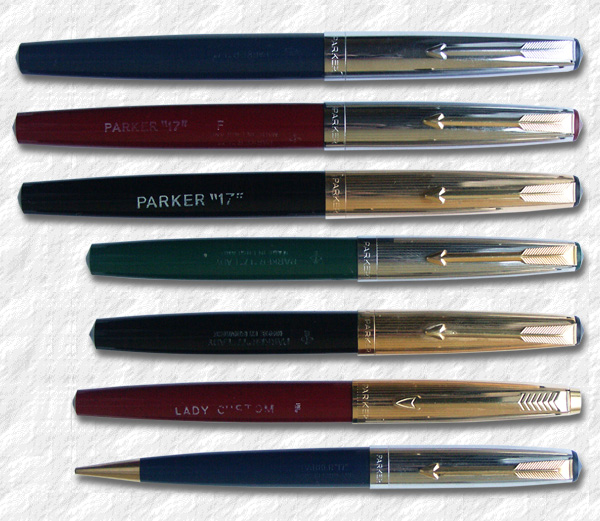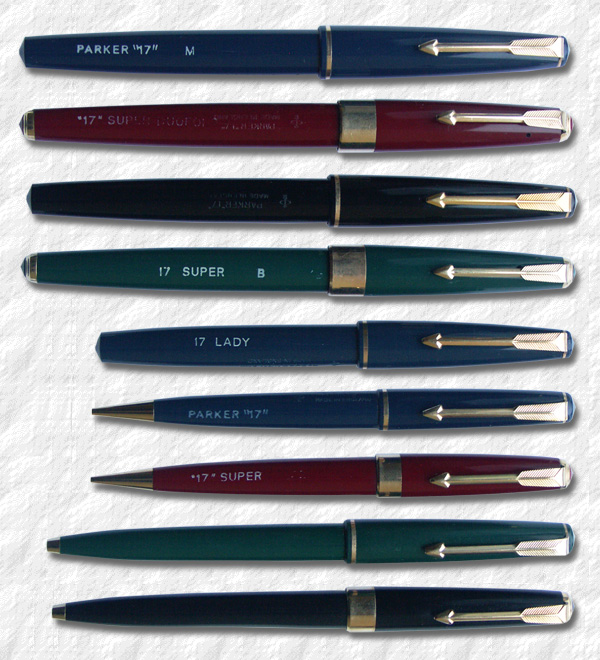
| parkerpens.net |
| PARKERCOLLECTOR.COM |
 The European Duofolds NS Duofold, AF Duofold |
||
In 1946 a new Duofold was introduced, the Duofold NS, New Style. This pen was fitted with an arrow clip and the old ball ended clip was discontinued, the clip screw was made of the same colour of plastic as the pen. It was still a button filler and sported a tassie ring on the blind cap, like the early Vacumatics. With these pens the engraved cap band found on the Major Vacumatics (app 4 mm) survived, a pattern of repeated chevrons leaning alternatively right and left: ///\\\///\\\. The 1946 colours were:
|
In 1948 the Duofold was changed again when the metallic button on the filler was transformed into an aluminium rod, rather than a button as such. This new pen was called The AF Duofold, aluminium filler. With this pen the tassie ring was also discontinued and the blind cap became rounded, like on later Vacumatics. Parker began offering matching pencils aswell. The colour scheme was also simplified. The 1948 colours were: The blue ones are the most hard to find today. Also the AF Duofold was made in Denmark, this time with the additional colours of |
|
Images © and courtesy of Adamon. |
Duofold NS, ca 1946. |
Another similar line was also produced in France during this time, Parker La Plume. The Senior, was also introduced in 1948. This followed the UK Duofold AF line, only it was bigger. Also a new, shorter model, the Demi Duofold was introduced in 1953. It was closely followed in 1954 by the Senior Duofold.
|
In 1958 both the Demi and the Senior were discontinued. The very large Maxima was introduced with the aerometric filling system. And the same year a smaller sized pen, the Lady Duofold, this had a hooded nib. It's not always easy to spot the differences between the models of the European Duofolds but some of the nibs were numbered to denote the model: #4 = Lady |
Images © and courtesy of Adamon. |
Duofold AF, ca 1948. |
They replaced the Standard Duofold, which was discontinued. In 1962 one of the best sellers from the British Duofold line, the Slimfold was introduced together with a smaller version of the standard Duofold, the Junior, The Parker "17"', the Slimfold and the Junior all sported a thinner cap band (app 1 mm) but it was still engraved in the same manner as the cap bands on the earlier pens. |
The Parker "17" and the Parker "17" Super both initially had open nibs but in 1964 the nibs on both models became hooded, although for a time they were offered side by side. They were not tubular in the manner of the Parker "51's", but still hidden under a plastic lip. The same year a Lady "17" was introduced and the "standard" Parker "17" was now referred to as the Model "17". The Duofold line in 1964: |
Images © and courtesy of Adamon. |
New Duofold, ca 1953. |
|
One of the few ads for the English Duofolds |
The Lady Standard was introduced in 1968, It was very similar to the Lady "17", but had a longer section. The same year the cap and clip was redesigned on the Lady, Slimfold and Junior, it was now much straighter and sported a Parker "45" style clip. Also in 1968 Parker gave up on the Eversharp sub brand and all the unprofitble Eversharp models were discontinued, the Challenger, Big E, 10,000 and Reporter. Instead Parker introduced a cheaper metal-capped version of the Parker "17", the DeLuxe. They were offered either with chrome or gold filled trim. The GFT-pens also had gold nibs, while the CT-pens had cheaper steel nibs. Later also a custom version with a gold filled cap and trim was introduced. Interestingly enough the at least the CT-version was produced in France and the parts, save the nibs, can not be interchanged. In late 1971 the Slimfold was redesigned yet again, maybe only to confuse latter day collectors. It now became very similar to the Parker "45", so similar in fact that it's kind of hard to differentiate between the two. The New Slimfold was 122 millimeters long with the cap on, as compared to the Parker "45" which was 136 millimeters in lenght. It also had the Parker "45" nib assembly and clip and since both pens are cartridge fillers the most significant difference is the screw-on cap of the New Slimfold, as opposed to the slip-on cap of the Parker "45". |
Even though they have handled time well, being sturdy, seldom failing writers as well as often being fitted with nice semi-flexible nibs, the British Duofold collection has somewhat failed to capture the minds of the collector community, save the Maxima which is very much sought for, but the rest of the line can still be found relatively cheap. Their only faults are a tendency to discolour if left for a long time in direct sunlight and being somewhat prone to developing dull finishes, due to the polystyrene plastic being softer than both celluloid and acrylic. They will never have the reputation of the high end Parkers, but with real gold nibs and as an introduction to the fountain pen users community, the European Duofolds of the era is well worth the prices they fetch. In 1988 Parker Newhaven introduced the Centennial Duofold, which was soon followed by the International and later the Demi. And the Duofold was again on the top of the list of Parker's best seller pens. Read more about them under the Centennial chapter, Since the size is the easiest way (apart from the imprint) to differentiate the models, here's a chart. Special thanks to Richard Williams and Adamon |
Images © and courtesy of Adamon. |
Three generations of UK Duofolds. |
Images © and courtesy of Adamon. |
Parker "17" DeLuxe. |
Images © and courtesy of Adamon. |
Parker "17" standard line. |
Images © and courtesy of Adamon. |
Junior sized Duofolds. |
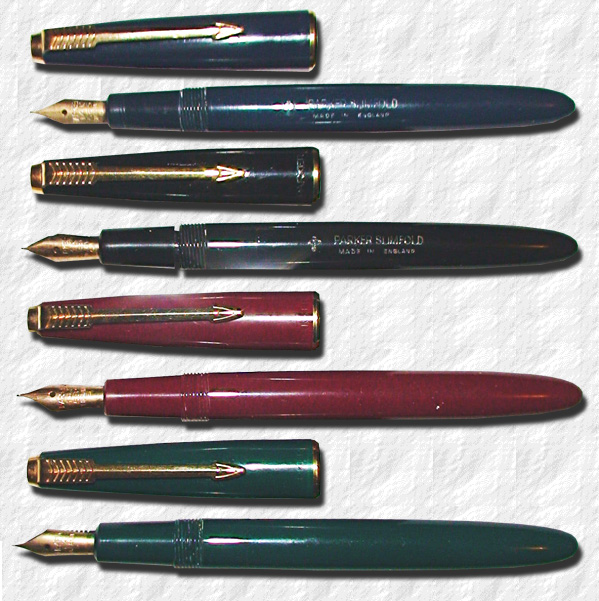 Images © and courtesy of Gerald McMullon. |
Slimfolds. |
© 1995-2019 Tony Fischier and The Parker Pen Company®/Sanford Ecriture.
This page is in no way sponsored by or created by the Parker Pen Company®. All opinions, views, and thoughts expressed herein are expressly the authors, and in no way reflect the opinions, views, or thoughts of the Parker Pen Company®/Sanford Ecriture. All logos and/or images on these pages are © Copyright of Parker Pen Company®Sanford Ecritureunless otherwise stated and is reprinted by kind permission. If You feel that Your copyright has been violated please contact the WEBMASTER.
Everything on this website is copyrighted by law and can not be used without written permission from the author, Tony Fischier. You may however use the information as reference material and although it is forbidden to make digital copies or reproductions it may be physically printed for personal use, which does not include use on other web pages or in advertising. You may however quote parts of the content of this website, digitally or physically, providing that the source and author is clearly stated, together with the copyright information. In the US referred to as Fair use. If you use any information on this site, add a link.
Feel free to donate a small sum through Paypal to help this site to stay online. Acknowledgements.
Parkercollector.com in translated versions
